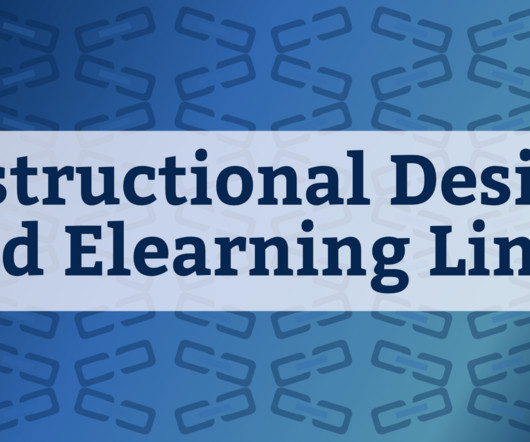Learning and Cognitive Load
B Online Learning
FEBRUARY 25, 2015
In a previous post, I looked at the fundamentals of cognitive load theory.
This site uses cookies to improve your experience. To help us insure we adhere to various privacy regulations, please select your country/region of residence. If you do not select a country, we will assume you are from the United States. Select your Cookie Settings or view our Privacy Policy and Terms of Use.
Cookies and similar technologies are used on this website for proper function of the website, for tracking performance analytics and for marketing purposes. We and some of our third-party providers may use cookie data for various purposes. Please review the cookie settings below and choose your preference.
Used for the proper function of the website
Used for monitoring website traffic and interactions
Cookies and similar technologies are used on this website for proper function of the website, for tracking performance analytics and for marketing purposes. We and some of our third-party providers may use cookie data for various purposes. Please review the cookie settings below and choose your preference.

B Online Learning
FEBRUARY 25, 2015
In a previous post, I looked at the fundamentals of cognitive load theory.

Hurix Digital
MAY 23, 2025
These changes have affected everything, from humans to business, and in todays competitive world, we are always stuck on a common question: How can we make learning truly effective through better instructional design? Heres where instructional design models come into play. Table of Contents: What is Instructional Design?
This site is protected by reCAPTCHA and the Google Privacy Policy and Terms of Service apply.
Can Your Organization Spot a Conflict Before It’s a Crisis?
How to Turn “Check-the-Box” Compliance Trainings Into Real Learning

Association eLearning
SEPTEMBER 20, 2017
a)cognitive overload. a) cognitive overload. By being shorter and more targeted than traditional course-length learning, microlearning helps manage cognitive load (how much information a learner is being asked to process at the same time) to prevent overload. True or False? Fill in the blank. This helps avoid. Fill in the blank.

Origin Learning
OCTOBER 15, 2014
What is cognitive load theory (CLT)? Attributable to John Sweller who developed this theory after thoroughly studying problem solving, CLT provides guidelines for improving learning and retention by focusing on the memory capacity of human beings. This is what a schema does: it helps in shedding some of the cognitive load.

Advertisement
Cognitive science theories already supply the answers. Learner engagement and retention doesn’t have to be a mystery. Learn how OttoLearn packages them into a single platform you can use to deliver microlearning based reinforcement training, and go beyond completions to focus on outcomes.

Infopro Learning
MAY 19, 2022
Include real-life scenarios and cognitive theories so that the learners can associate themselves with the facts and situations. It requires flawless instructional design as it’s reliant on curriculum development. The idea is to eliminate monotonous communication. Plus, it will help them in grasping the new information easily.

E-Learning Provocateur
JANUARY 12, 2010
Academia is teeming with learning theories. It can be quite a challenge for the modern learning professional to identify an appropriate learning theory, draw practical ideas from it, and apply it to their daily work. Which theory do you choose? How does it relate to other theories? Where do you start? Overarching themes.

Adobe Captivate
NOVEMBER 28, 2017
“eLearning when designed correctly with sound instructional design strategy has the potential to bring organizational excellence with a positive eLearning ROI. ” An instructional strategy is an action plan or a method to help people learn. In such cases, Microlearning can be the best learning strategy that reduces cognitive overload.

LearnDash
FEBRUARY 2, 2021
If I had to guess, I would say that most online educators don’t think of themselves as “instructional designers.” This is where instructional design comes in. During the twentieth century, four major learning theories emerged, and each has lessons that online educators can learn from to design better courses.

Kapp Notes
MAY 23, 2011
Here are some thoughts and ideas related to Albert Bandura’s social learning theory. Bandura’s social learning theory indicates the effectiveness of human social models in influencing another to change behaviors, beliefs or attitudes, as well as social and cognitive functioning.

B Online Learning
SEPTEMBER 7, 2017
Research into our cognitive architecture has lead to the development of Cognitive Load Theory (CLT) and related guidelines which, when applied, results in more efficient learning. It offers principles and instructional guidelines. It’s evidence based, there’s been lots of studies and experiments to test the theory.

Experiencing eLearning
APRIL 16, 2019
The links and resources in this post include collections of research, specific research on retrieval practice, an overview of learning theories, H5P’s new branching scenario option, and a widget for changing the colors in the Storyline modern player. Cognitive load, spacing effect, forgetting effect, worked examples, and more.

Kapp Notes
JANUARY 17, 2013
I am often asked if an instructional or training game should be “realistic” or can the game have “fantasy” elements and still be an effective learning tool. He wrote that fantasy was key element to making an instructional game motivational. There are both cognitive and emotional reasons for evoking fantasy.

Experiencing eLearning
FEBRUARY 15, 2022
If you’re not active in L&D Twitter, you might have missed the big debate recently about whether and how research is relevant to the work of instructional designers and corporate training professionals. Essentially, any time you do instructional writing (scripts, online text, instructions, etc.), Conversational tone.

Clarity Consultants
SEPTEMBER 21, 2023
As companies increasingly turn to eLearning platforms to facilitate employee training and development, it’s crucial to understand the cognitive processes at play. Let’s look into the fascinating world of Cognitive Load Theory and explore how it impacts learning from a corporate perspective.

Experiencing eLearning
MARCH 14, 2023
This post includes links on growth mindset, an AI tool for instructional design, branching scenarios, accessibility, and a magazine issue with elearning articles by multiple prominent authors. Growth mindset Ask the Cognitive Scientist: Does Developing a Growth Mindset Help Students Learn?

Kapp Notes
SEPTEMBER 12, 2012
Curiosity in terms of sensory and cognitive inquisitiveness. Fantasy in terms of the emotional and cognitive aspects of fantasy as well as the interweaving of the fantasy and the skills to be learned within the game. Aptitude, learning and instruction: Vol. Cognitive and affective process analyse s (pp. Snow & M.J.

Integrated Learnings
DECEMBER 12, 2012
I recently started reading Thinking, Fast and Slow by Daniel Kahneman, and the chapter on cognitive ease offered all sorts of implications for eLearning design. This, combined with additional discussion in the book, suggests that a bad mood creates cognitive strain, and a good mood promotes cognitive ease. By Shelley A.

Upside Learning
SEPTEMBER 7, 2010
They need to support the text and be used, not for diversion, but a clear instructional purpose. Graphics should then provide a clear representation of the content to be remembered, without extraneous information.This principle is supported by Paivio’s Dual Coding Theory. Make sure that text does not run into frames or graphics.

Kapp Notes
MAY 27, 2011
Recently, I posted about Bandura’s Social learning theory , this posting continues the discussion and relates it specifically to instruction involving avatars. Social Learning Theory. Social learning theory is based on the premise that observation and imitation by an individual leads to learned behavior.

Origin Learning
DECEMBER 23, 2014
Instructional design is certainly not an easy business. Instructional designers shoulder the important responsibility of sugar-coating the critical learning content in such a manner that training becomes not just a mandatory activity, but something that employees love. Now how do you do that? The question is- what to put where.

Experiencing eLearning
MARCH 8, 2022
… We must be able to see the gaps in our instructional design, which learning science helps to support. If we want to avoid doing slide presentations, we have to know what cognitive (and emotional) advantages these technologies have so we can leverage them for success. 50 Totally Free Lessons in Graphic Design Theory.

Kapp Notes
SEPTEMBER 11, 2014
Like any good instructional method, they have to be used intelligently and in conjunction with other instructional elements to be effective for learning. A Meta-Analysis of the Cognitive and Motivational Effects of Serious Games. terms of learning and more motivating than conventional instruction methods (learning: k = 77, N.

Kapp Notes
JUNE 30, 2011
For a while I have been stealthy working on a book titled “The Gamification of Learning and Instruction&#. What is gamification and what does that mean to faculty members, college instructors, instructional designers and other learning and development practitioners. The first chapter introduces terminology. What is a game?

Experiencing eLearning
JULY 3, 2011
Big Dog, Little Dog: Five Years later: A Review of Kirschner, Sweller and Clark’s Why Minimal Guidance during Instruction Does Not Work. The paper relies heavily on Cognitive Load Theory, yet we have to realize that it is still a theory rather than a law. tags: learning training pbl constructivism research inquiry.

Clark Quinn
NOVEMBER 23, 2021
Yet, I realize that there may be another legacy, a cognitive one. The cognitive approach is certainly more recent than the Industrial Age, but it carries its own legacies. Yet we also are good at pattern-matching and meaning-making (sometimes too good; *cough* conspiracy theories *cough*). The premise comes from business.

eLearning Industry
NOVEMBER 23, 2019
As learning designers, you have certainly heard of cognitive load theory and it has helped you make informed design decisions. According to cognitive load theory, working memory should not be overloaded in that it disrupts learning because that is where learning is being processed.

Kapp Notes
JANUARY 27, 2014
I think the same model can be used when you think about and design a gamification interaction or again, other types of instruction. Mode 1: Cognitive interactivity or interpretative participation. Discussion approach to instruction. Instructional-design theories and models: Vol. Reigeluth, A. Carr-Chellman (Eds.),

Scissortail's Learning Nest
SEPTEMBER 16, 2024
The Cognitive Accessibility Guidance identifies eight objectives to reduce barriers for people with cognitive, intellectual, and learning disabilities, as well as neurodivergent (or neurologically different) individuals. Cognitive Accessibility Guidance The Cognitive Accessibility Guidance is organized under eight objectives.

Experiencing eLearning
MARCH 1, 2012
It made intuitive sense, and I’d never heard a real criticism of the theory. If I think back to the way learning styles were taught to me though, it was never applied the way that the theory is “officially” supposed to work. As an instructional designer, I basically ignore learning styles.

E-Learning Provocateur
JULY 4, 2021
And this makes sense to me, as the cognitive load is reduced in each session, and I presume the time intervals accommodate further cognitive processing that embeds the concepts deeper into long-term memory. Reinforcement. This approach enables our target audience to weave it into their work day… and make it stick.

eLearning Industry
APRIL 16, 2021
Cognitive load theory explains why it’s important to give employees exactly what they can handle, in a format that makes sense, so that they can learn, retain, and make use of the training. Here’s your guide to cognitive load theory and why it's so incredibly important to employee learning.

Dashe & Thomson
FEBRUARY 4, 2014
Instructional Designers often strive to develop training material that is concise and easily digested by the target learners. Learning Style Theory Cognitive Strain CRT elearning instructional design Learning Theory' They also strive to create assessments and questions that are valid, clear, and direct.

eLearning Industry
NOVEMBER 3, 2023
Schema theory, proposed by Jean Piaget in 1952, is a fundamental concept in the field of cognitive psychology that focuses on how individuals organize and process information. Piaget's theory explains how people develop cognitive structures, or "schemas," to make sense of their experiences.

eLearning Brothers
JUNE 20, 2018
When I’ve attended eLearning conferences and workshops, one thing I’ve noticed is that instructional designers are always hungry for more research and knowledge on how people learn and what they can do to help them learn better. Marty is an expert on cognitive science and learning experience design. Give us a ring!

The Learning Rooms
APRIL 11, 2025
An instructional design framework used to design effective learning. A term to describe adult learning theory. An instructional design model for motivation. A learning theory developed by B.F C Cognitive Load. Cognitive Overload. A learning theory for the digital age developed by George Siemens.

eLearning Industry
MAY 22, 2019
Reducing cognitive load can make all the difference when designing great digital learning content. But, given the fact that most of us don’t have a degree in psychology, what exactly does cognitive load mean, and how can it be reduced? This post was first published on eLearning Industry.

The eLearning Coach
APRIL 23, 2019
John Sweller, who formulated cognitive load theory, explains how instructional designers can design more effective learning experiences.

IT Training Department Blog
JULY 10, 2023
Whether you’re in the instructional design world and are familiar with cognitive load theory or on the content side of things, content overload has the same negative impact on workplace learning. Here is one important role an instructional designer plays in reducing content overload.

Making Change
SEPTEMBER 21, 2010
Here’s what four cognitive psychologists concluded: “The contrast between the enormous popularity of the learning-styles approach within education and the lack of credible evidence for its utility is, in our opinion, striking and disturbing. study found no clear evidence supporting any of the many theories about learning styles.

Making Change
SEPTEMBER 21, 2010
Here’s what four cognitive psychologists concluded: “The contrast between the enormous popularity of the learning-styles approach within education and the lack of credible evidence for its utility is, in our opinion, striking and disturbing. study found no clear evidence supporting any of the many theories about learning styles.

Clark Quinn
NOVEMBER 16, 2021
I want to dig a wee bit further into the cognitive and formal aspects of this to backstop her points. Also, of course, to make the point that a cognitive perspective provides important insight.). This naturally includes cognition as the basis for learning, experiences, and design. Creativity is the flip side of innovation.

Kapp Notes
SEPTEMBER 20, 2012
As learning professionals, it is important that we understand that novice learners and expert learners demand/require and need a different approach to instruction. You cannot develop learning events for novices using the same instructional strategies as you do for someone who has a high level of knowledge in a content area.
Expert insights. Personalized for you.
Are you sure you want to cancel your subscriptions?


Let's personalize your content